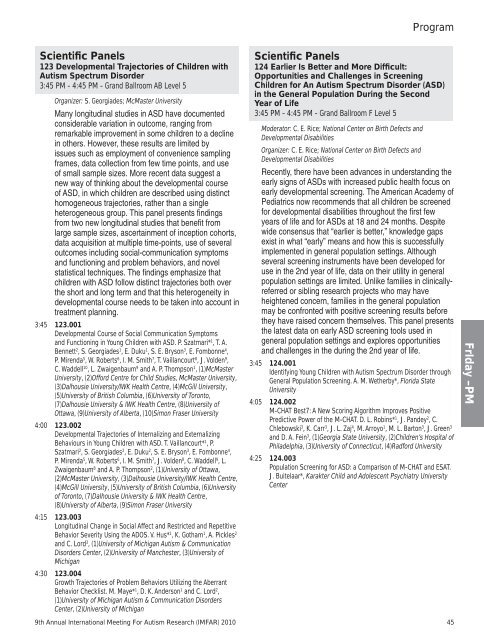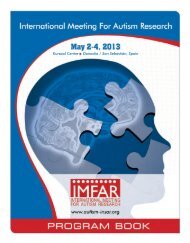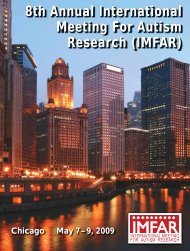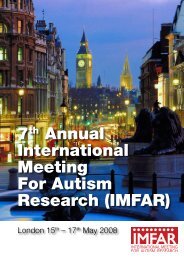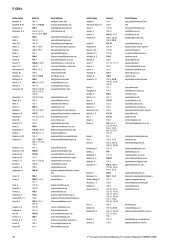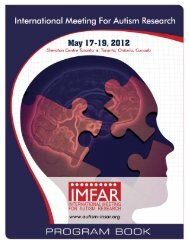9th Annual International Meeting For Autism Research ... - Confex
9th Annual International Meeting For Autism Research ... - Confex
9th Annual International Meeting For Autism Research ... - Confex
You also want an ePaper? Increase the reach of your titles
YUMPU automatically turns print PDFs into web optimized ePapers that Google loves.
Program<br />
Scientific Panels<br />
123 Developmental Trajectories of Children with<br />
<strong>Autism</strong> Spectrum Disorder<br />
3:45 PM - 4:45 PM - Grand Ballroom AB Level 5<br />
Organizer: S. Georgiades; McMaster University<br />
Many longitudinal studies in ASD have documented<br />
considerable variation in outcome, ranging from<br />
remarkable improvement in some children to a decline<br />
in others. However, these results are limited by<br />
issues such as employment of convenience sampling<br />
frames, data collection from few time points, and use<br />
of small sample sizes. More recent data suggest a<br />
new way of thinking about the developmental course<br />
of ASD, in which children are described using distinct<br />
homogeneous trajectories, rather than a single<br />
heterogeneous group. This panel presents findings<br />
from two new longitudinal studies that benefit from<br />
large sample sizes, ascertainment of inception cohorts,<br />
data acquisition at multiple time-points, use of several<br />
outcomes including social-communication symptoms<br />
and functioning and problem behaviors, and novel<br />
statistical techniques. The findings emphasize that<br />
children with ASD follow distinct trajectories both over<br />
the short and long term and that this heterogeneity in<br />
developmental course needs to be taken into account in<br />
treatment planning.<br />
3:45 123.001<br />
Developmental Course of Social Communication Symptoms<br />
and Functioning in Young Children with ASD. P. Szatmari* 1 , T. A.<br />
Bennett 2 , S. Georgiades 1 , E. Duku 1 , S. E. Bryson 3 , E. Fombonne 4 ,<br />
P. Mirenda 5 , W. Roberts 6 , I. M. Smith 7 , T. Vaillancourt 8 , J. Volden 9 ,<br />
C. Waddell 10 , L. Zwaigenbaum 9 and A. P. Thompson 1 , (1)McMaster<br />
University, (2)Offord Centre for Child Studies, McMaster University,<br />
(3)Dalhousie University/IWK Health Centre, (4)McGill University,<br />
(5)University of British Columbia, (6)University of Toronto,<br />
(7)Dalhousie University & IWK Health Centre, (8)University of<br />
Ottawa, (9)University of Alberta, (10)Simon Fraser University<br />
4:00 123.002<br />
Developmental Trajectories of Internalizing and Externalizing<br />
Behaviours in Young Children with ASD. T. Vaillancourt* 1 , P.<br />
Szatmari 2 , S. Georgiades 2 , E. Duku 2 , S. E. Bryson 3 , E. Fombonne 4 ,<br />
P. Mirenda 5 , W. Roberts 6 , I. M. Smith 7 , J. Volden 8 , C. Waddell 9 , L.<br />
Zwaigenbaum 8 and A. P. Thompson 2 , (1)University of Ottawa,<br />
(2)McMaster University, (3)Dalhousie University/IWK Health Centre,<br />
(4)McGill University, (5)University of British Columbia, (6)University<br />
of Toronto, (7)Dalhousie University & IWK Health Centre,<br />
(8)University of Alberta, (9)Simon Fraser University<br />
4:15 123.003<br />
Longitudinal Change in Social Affect and Restricted and Repetitive<br />
Behavior Severity Using the ADOS. V. Hus* 1 , K. Gotham 1 , A. Pickles 2<br />
and C. Lord 3 , (1)University of Michigan <strong>Autism</strong> & Communication<br />
Disorders Center, (2)University of Manchester, (3)University of<br />
Michigan<br />
4:30 123.004<br />
Growth Trajectories of Problem Behaviors Utilizing the Aberrant<br />
Behavior Checklist. M. Maye* 1 , D. K. Anderson 1 and C. Lord 2 ,<br />
(1)University of Michigan <strong>Autism</strong> & Communication Disorders<br />
Center, (2)University of Michigan<br />
Scientific Panels<br />
124 Earlier Is Better and More Difficult:<br />
Opportunities and Challenges in Screening<br />
Children for An <strong>Autism</strong> Spectrum Disorder (ASD)<br />
in the General Population During the Second<br />
Year of Life<br />
3:45 PM - 4:45 PM - Grand Ballroom F Level 5<br />
Moderator: C. E. Rice; National Center on Birth Defects and<br />
Developmental Disabilities<br />
Organizer: C. E. Rice; National Center on Birth Defects and<br />
Developmental Disabilities<br />
Recently, there have been advances in understanding the<br />
early signs of ASDs with increased public health focus on<br />
early developmental screening. The American Academy of<br />
Pediatrics now recommends that all children be screened<br />
for developmental disabilities throughout the first few<br />
years of life and for ASDs at 18 and 24 months. Despite<br />
wide consensus that “earlier is better,” knowledge gaps<br />
exist in what “early” means and how this is successfully<br />
implemented in general population settings. Although<br />
several screening instruments have been developed for<br />
use in the 2nd year of life, data on their utility in general<br />
population settings are limited. Unlike families in clinicallyreferred<br />
or sibling research projects who may have<br />
heightened concern, families in the general population<br />
may be confronted with positive screening results before<br />
they have raised concern themselves. This panel presents<br />
the latest data on early ASD screening tools used in<br />
general population settings and explores opportunities<br />
and challenges in the during the 2nd year of life.<br />
3:45 124.001<br />
Identifying Young Children with <strong>Autism</strong> Spectrum Disorder through<br />
General Population Screening. A. M. Wetherby*, Florida State<br />
University<br />
4:05 124.002<br />
M-CHAT Best7: A New Scoring Algorithm Improves Positive<br />
Predictive Power of the M-CHAT. D. L. Robins* 1 , J. Pandey 2 , C.<br />
Chlebowski 3 , K. Carr 3 , J. L. Zaj 4 , M. Arroyo 1 , M. L. Barton 3 , J. Green 3<br />
and D. A. Fein 3 , (1)Georgia State University, (2)Children’s Hospital of<br />
Philadelphia, (3)University of Connecticut, (4)Radford University<br />
4:25 124.003<br />
Population Screening for ASD: a Comparison of M-CHAT and ESAT.<br />
J. Buitelaar*, Karakter Child and Adolescent Psychiatry University<br />
Center<br />
FrIday –PM<br />
<strong>9th</strong> <strong>Annual</strong> <strong>International</strong> <strong>Meeting</strong> <strong>For</strong> <strong>Autism</strong> <strong>Research</strong> (IMFAR) 2010 45


